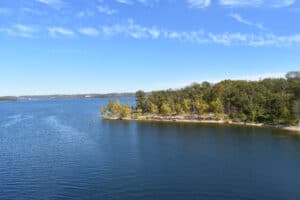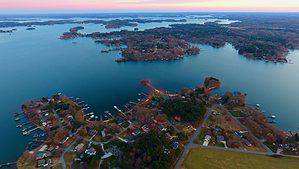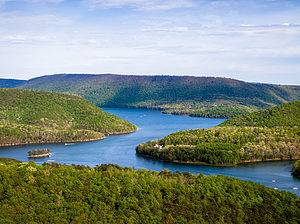North America boasts a vast, rich area for harboring huge ecosystems and biodiversity. Being the home of the five Great Lakes, the continent holds 20% of the Earth’s freshwater, hosting the world’s largest freshwater system that provides fresh water for the continent’s consumption, recreation, power, and many other uses. Yet, apart from the five Great Lakes, North America hosts many other lakes, each boasting massive water volume that connects and flows throughout a vast system of streams and rivers across the continent. North America encompasses the United States and neighboring countries like Canada, Greenland, Mexico, Cuba, Jamaica, and more.
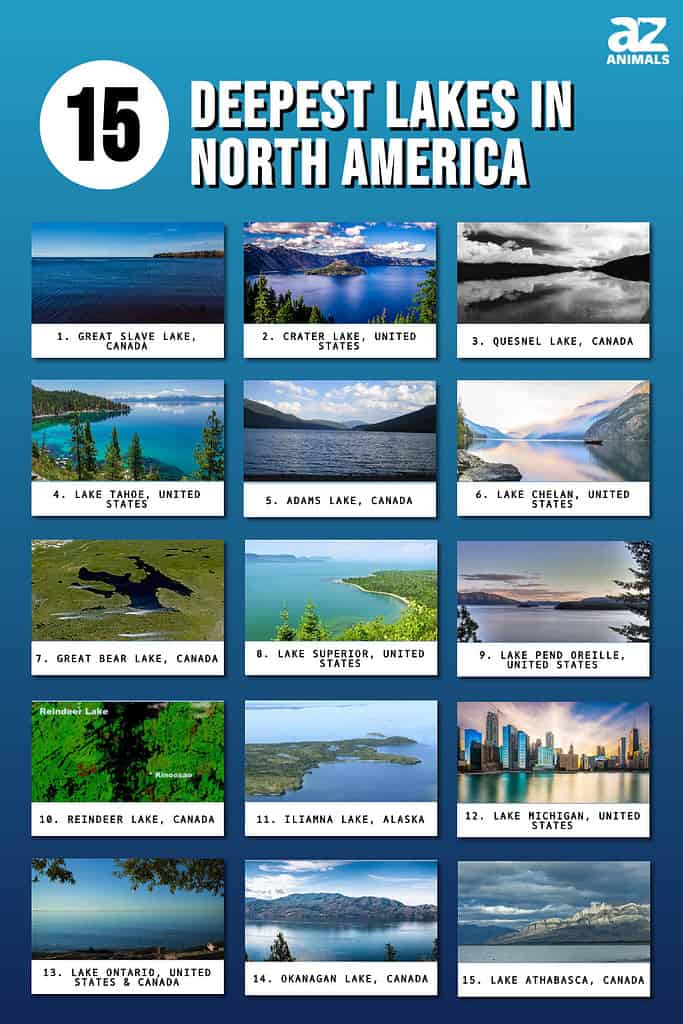
The continent hosts many lakes – apart from natural lakes endemic to the continent, thousands of man-made lakes also sit across its land. But among all these natural and man-made lakes, which is the deepest? This article will explore the 15 deepest lakes in North America and other facts about them.
The 15 Deepest Lakes In North America
1. Great Slave Lake, Canada
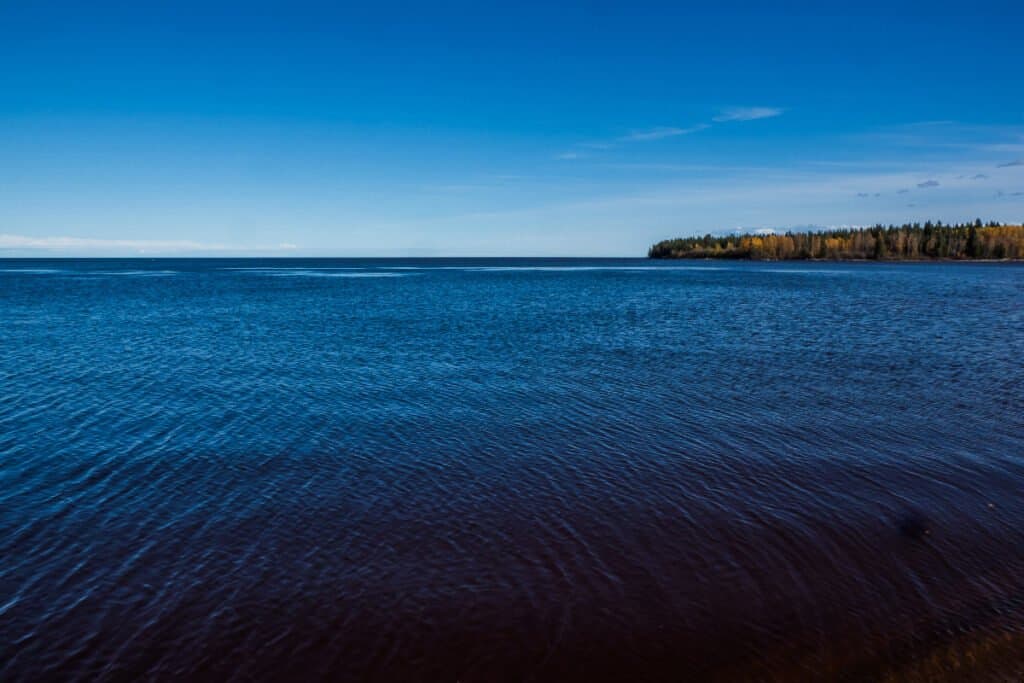
Great Slave Lake is the deepest lake in North America.
©norikko/Shutterstock.com
The Canadian Lake, Great Slave Lake, holds the crown as the deepest lake in the entire North American continent. With a maximum depth that reaches 2,014 feet or 614 meters deep, the lake is also the 8th deepest lake on the planet. Apart from having the highest depth, Great Slave Lake is Canada’s second-largest lake, having a surface area of 10,502 square miles. The lake sits in Canada’s Northwest Territories, bordered by large bays and rocky slopes. Its main water contributor is the Slave River which drains its water through the Mackenzie River down to the Arctic Ocean.
2. Crater Lake, USA
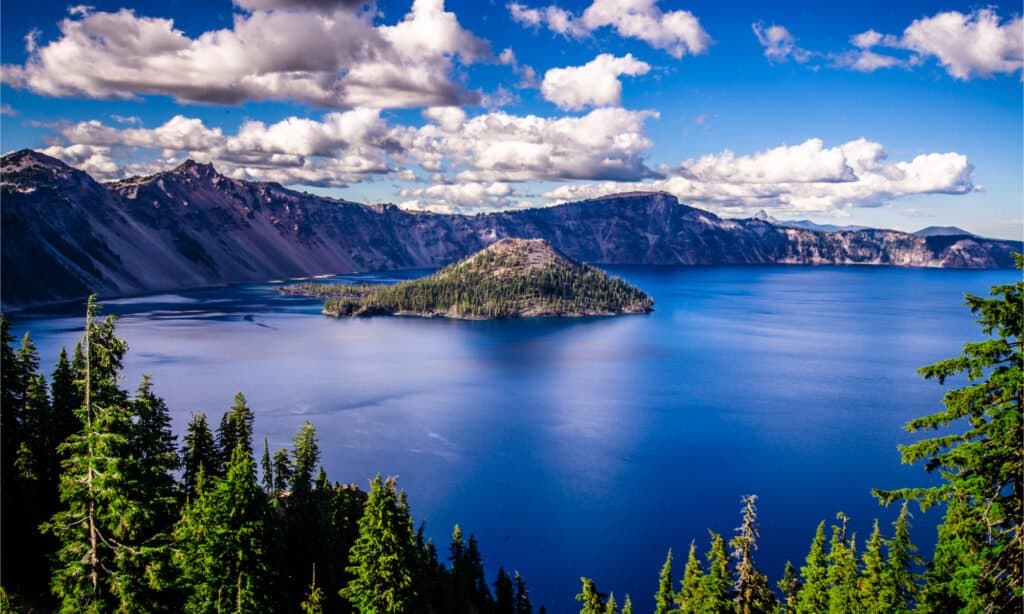
With a depth of 1943 feet, Crater Lake is the 2nd deepest lake in North America and 9th in the world.
©Pung/Shutterstock.com
Following Great Slave Lake by maximum depth is Crater Lake in the United States. With a depth of 1,943 feet or 594 meters, Crater Lake also ranks as the 9th deepest lake in the world. Despite its depth, Crater Lake is famous for its stunning blue color, in which water comes directly from snow or rain. Since it is a crater lake formed by a mountain’s collapse thousands of years ago, it has no other entrances or water sources, making its water pure and free of debris or mineral deposits. The water in Crater Lake remains clean and is one of the clearest in the world.
3. Quesnel Lake, Canada
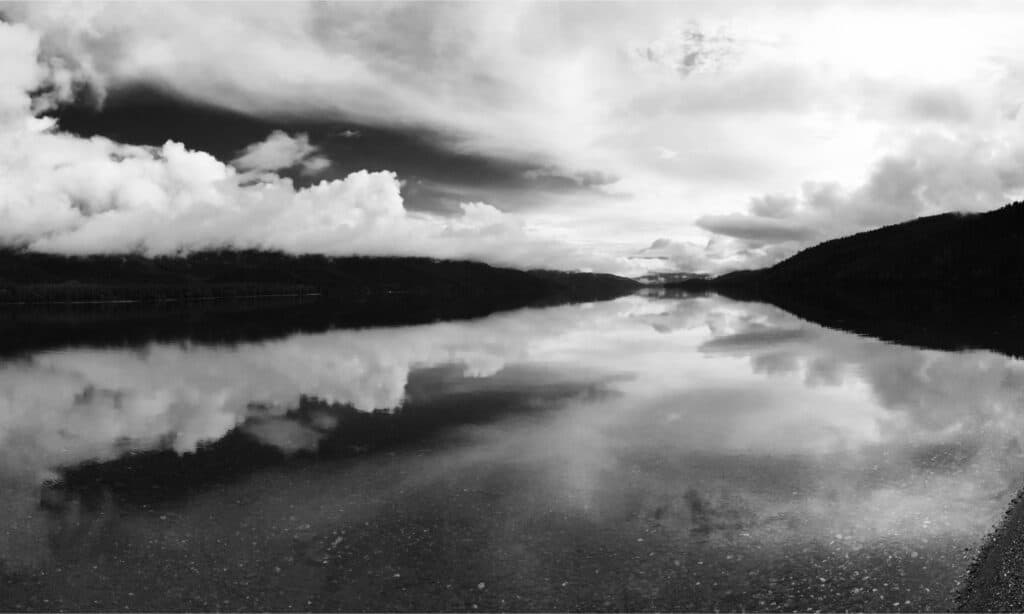
Quesnel Lake is the deepest fjord in the world.
©Morseofphoto/Shutterstock.com
Located in British Columbia, Canada, Quesnel Lake is the third deepest lake in North America and the deepest fjord in the world. The Quesnel Lake has a maximum depth of 1,677 feet or 511 meters, making it the deepest lake in British Columbia. Fishing, forestry, and mining make the area popular, hosting rich marine biodiversity and freshwater fish species such as bull trout, rainbow trout, lake trout, salmon, and more. The lake’s fertile destination makes it a must-fish spot for fishers and anglers.
4. Lake Tahoe, United States
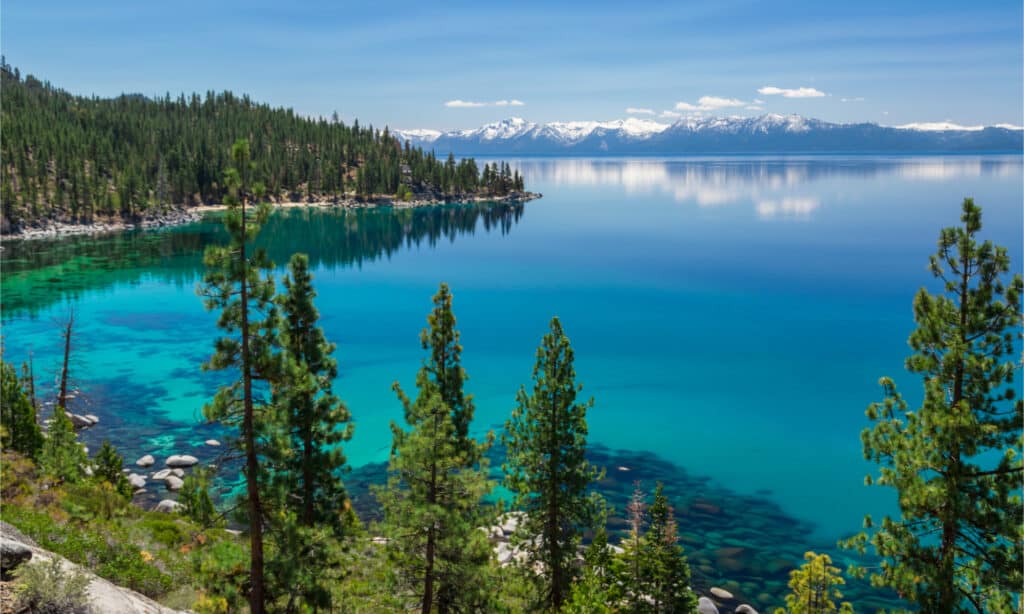
The fourth deepest lake in North America, Lake Tahoe is also one of the cleanest freshwater lakes globally.
©topseller/Shutterstock.com
With a maximum depth of 1,645 feet or 501 meters, Lake Tahoe is the fourth deepest lake in North America. It is located in the Sierra Nevada in the United States, straddling between the state lines of Nevada and California. Measuring by volume, Lake Tahoe is the second largest lake in the U.S, next to Crater Lake. It is also the largest alpine lake on the continent, lying at 6,225 feet or 1,897 meters above sea level. Apart from all these distinctions, Lake Tahoe is also one of the cleanest and purest freshwaters globally, having a percentage of 99.994% in terms of water purity, which is only a few points behind distilled water with 99.998% standard purity.
5. Adams Lake, Canada
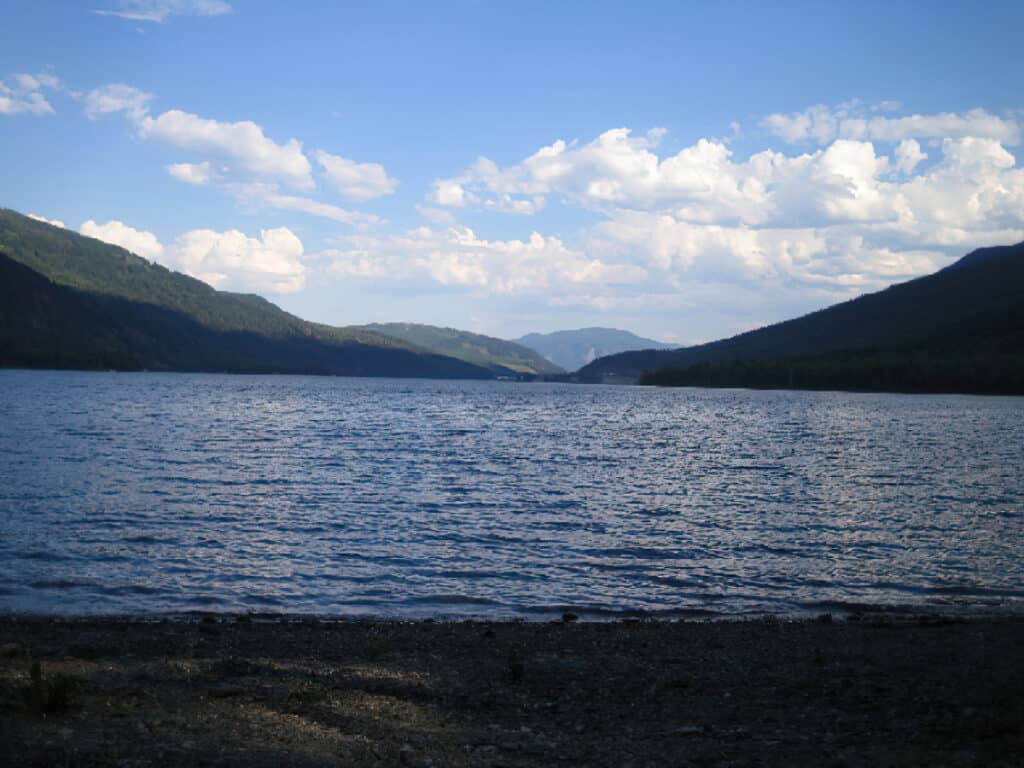
Located in British Columbia, Canada, Adams Lake is the fifth deepest lake in North America.
©Globalist1789 at English Wikipedia / This work has been released into the public domain by its author, Globalist1789 at English Wikipedia. This applies worldwide. In some countries this may not be legally possible; if so: Globalist1789 grants anyone the right to use this work for any purpose, without any conditions, unless such conditions are required by law.
Another one of North America’s deepest lakes is in British Columbia, Canada. Adams Lake has a maximum depth of 1,499 feet or 457 meters, making it the second deepest lake in British Columbia, next to Quesnel Lake. Its main tributaries include the Upper Adams River, Bush Creek, and Momich River. The lake drains its water via the Lower Adams River, famous for the abundance of sockeye salmon species that attracts tourists annually. Few natural beaches occupy the lake, while some artificial ones were built for public use, like the Adams Lake National Park.
6. Lake Chelan, United States
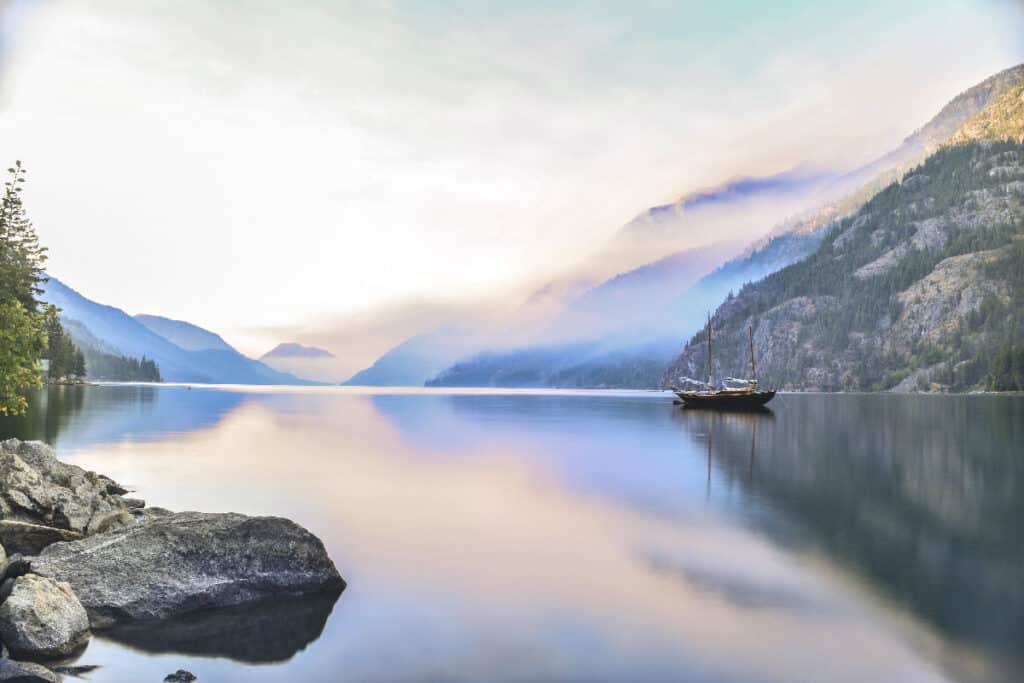
Lake Chelan is the sixth deepest lake in North America.
©iStock.com/jmacarthur
With a maximum depth of 1,486 feet or 453 meters, Lake Chelan is the sixth deepest lake in North America, the third deepest in the United States, and the 25th in the world. “Chelan” is derived from a Salish indigenous term meaning “deep water.” One community sits at the lake’s northern end that connects it to the North Cascades National Park, and two other communities lie in the lake’s southern region. It comprises two basins – a lower basin with a shallower depth and the upper basin, which is much deeper and contains its deepest point.
7. Great Bear Lake, Canada
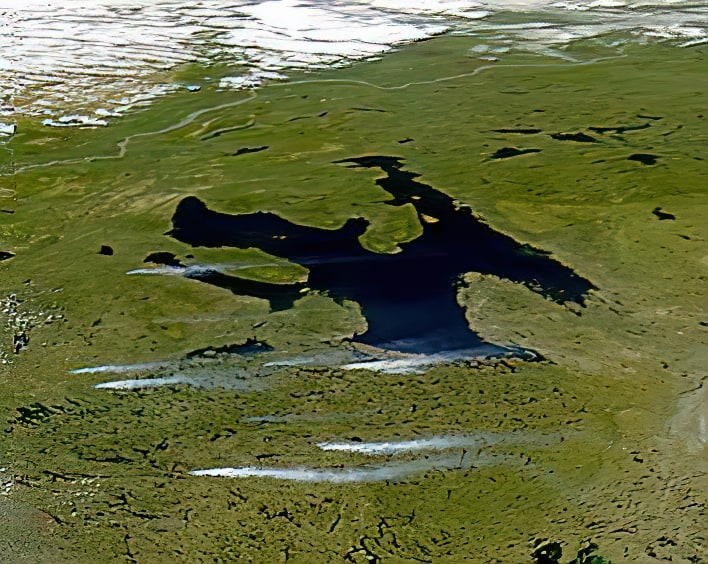
With a depth of 1463 feet, the Great Bear Lake is the fourth largest in North America.
©NASA / This file is in the public domain in the United States because it was solely created by NASA. NASA copyright policy states that “NASA material is not protected by copyright unless noted”. (See Template:PD-USGov, NASA copyright policy page or JPL Image Use Policy.)
Having a maximum depth of 1,463 feet or 446 meters, the Great Bear Lake ranks among the top 10 deepest lakes in North America. Yet, in terms of surface area, it hails as the largest lake entirely within the Canadian territory and the fourth largest in the whole continent. The Great Bear Lake has an irregular shape and contains numerous small islands that make it a perfect habitat for freshwater fish, such as the remarkable speckled trout. It is named after one of its incredible inhabitants, the grizzly bear. It also hosts several other animals like moose, musk-ox, fox, wolverine, etc.
8. Lake Superior, United States
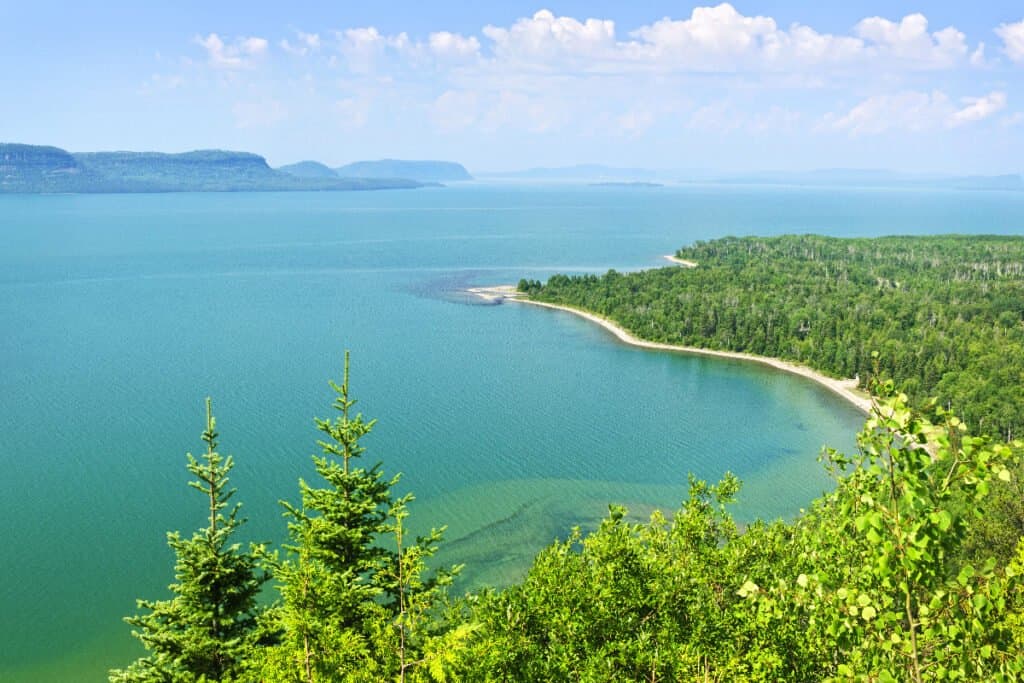
Lake Superior, the deepest and largest Great Lake, has 10% of the world’s surface fresh water
©Elena Elisseeva/Shutterstock.com
It is not surprising that it is named Lake Superior because it is indeed a vast and deep lake. Lake Superior holds 2,900 cubic miles of water and consists of 10% of the Earth’s freshwater. It covers 37,700 square miles or 82,103 square kilometers and has a maximum depth of 1,333 feet or 406 meters, making it the deepest and largest among the five Great Lakes. The lake contains a massive volume of water that emptying it would take almost two centuries! Even all waters of the four Great Lakes combined won’t equate to Lake Superior’s water volume. Because of this, it hosts rich biodiversity and serves as an essential route for merchandise transportation.
9. Lake Pend Oreille, United States
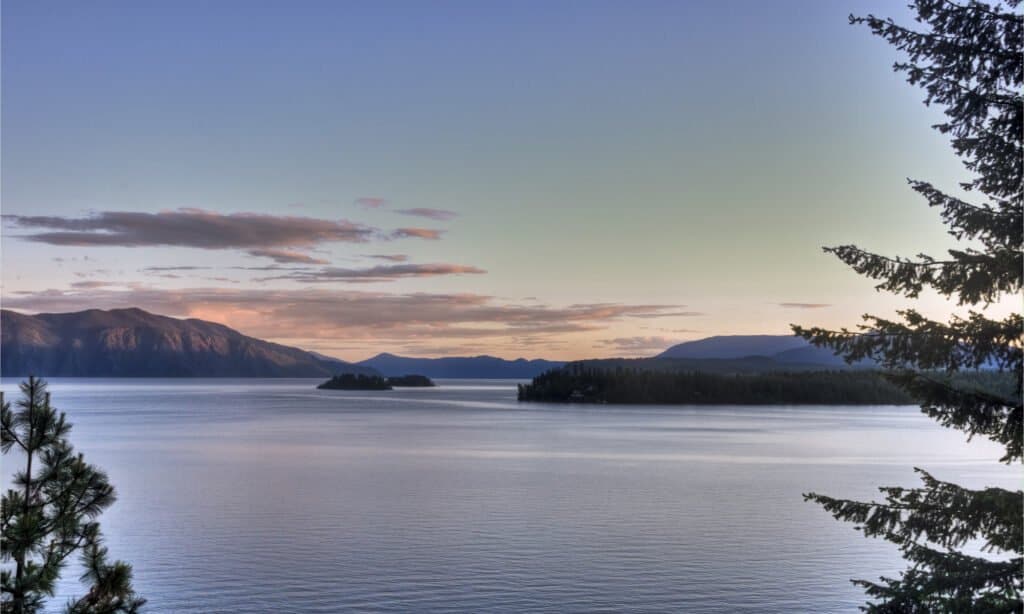
Lake Pend Oreille measures 1150 ft deep and is the 9th deepest lake in North America.
©Jeffrey T. Kreulen/Shutterstock.com
Sitting in the northern Idaho Panhandle, Lake Pend Oreille measures 43 miles or 69 kilometers long and 1,150 feet or 350 meters deep. The lake ranks as the 9th deepest lake in the continent and the 5th among the lakes in the U.S. With a surface area of 383 square kilometers, Lake Pend Oreille is Idaho’s largest lake.
10. Reindeer Lake, Canada
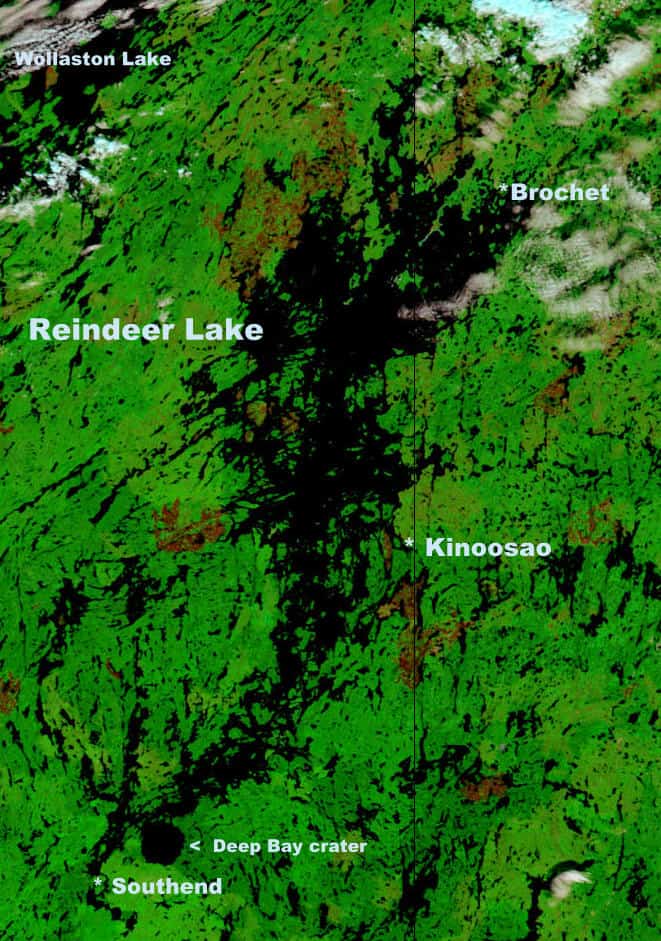
Measuring up to 720 feet,
Reindeer
Lake is the 10th deepest lake in North America.
©Jacques Descloitres, MODIS Land Rapid Response Team, NASA/GSFC / This file is in the public domain in the United States because it was solely created by NASA. NASA copyright policy states that “NASA material is not protected by copyright unless noted”. (See Template:PD-USGov, NASA copyright policy page or JPL Image Use Policy.)
Located in western Canada, Reindeer Lake measures up to 720 feet or 220 meters deep, making it the 10th deepest lake in North America. It sits along the border between Saskatchewan and Manitoba and is the 24th largest lake globally by surface area. As one of Canada’s largest lakes, it is an essential spot for its fishing industry. Sport-fishermen also love the lake for its clear and deep waters.
11. Iliamna Lake, Alaska
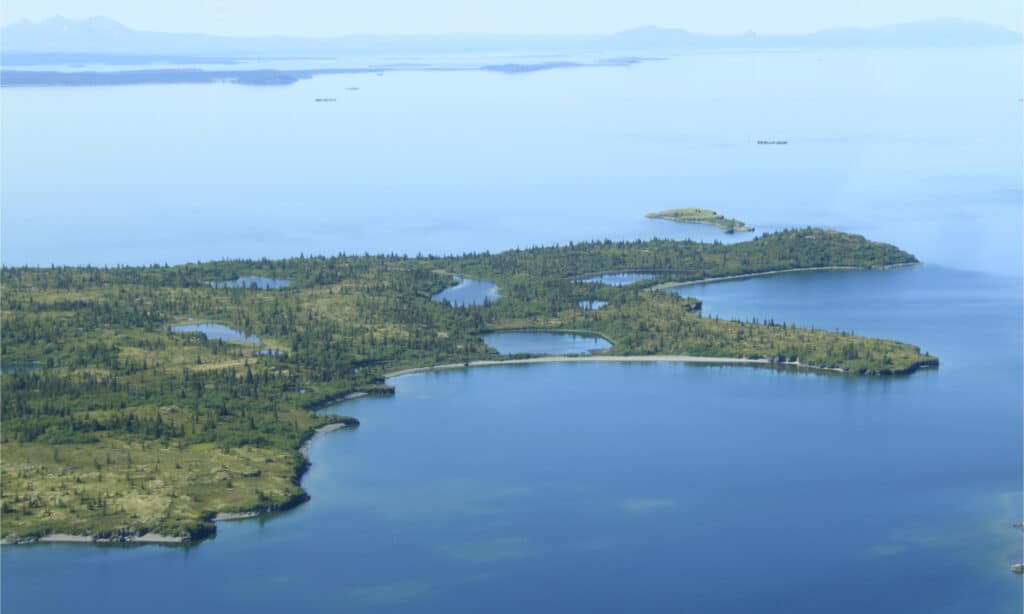
The largest lake in Alaska and the third largest lake in the U.S. is the Iliamna Lake.
©Nessie91/Shutterstock.com
Iliamna Lake is Alaska’s first entry on this list. It is the largest lake in Alaska and the third largest lake entirely within the United States territory. The deepest point of Iliamna Lake measures 988 feet or 301 meters. It is also a perfect spot for the fishing industry as it is home to numerous freshwater fish such as various types of trout, salmon, and pike.
12. Lake Michigan, United States

At 923 feet, Lake Michigan is one of the largest lakes in North America.
©Sean Pavone/Shutterstock.com
One of the Great Lakes enters the list once again. With varying depths, Lake Michigan’s deepest point lies at the Chippewa Basin, at 923 feet or 281 meters. Lake Michigan is one of the largest lakes in the continent by surface area but is one of the largest lakes inside the United States that doesn’t touch other countries borders. Approximately one quadrillion gallons of water or 1,200 cubic miles fill the lake with water coming from several tributaries. Lake Michigan touches four U.S. states, namely, Michigan, Illinois, Indiana, and Wisconsin.
13. Lake Ontario, United States & Canada
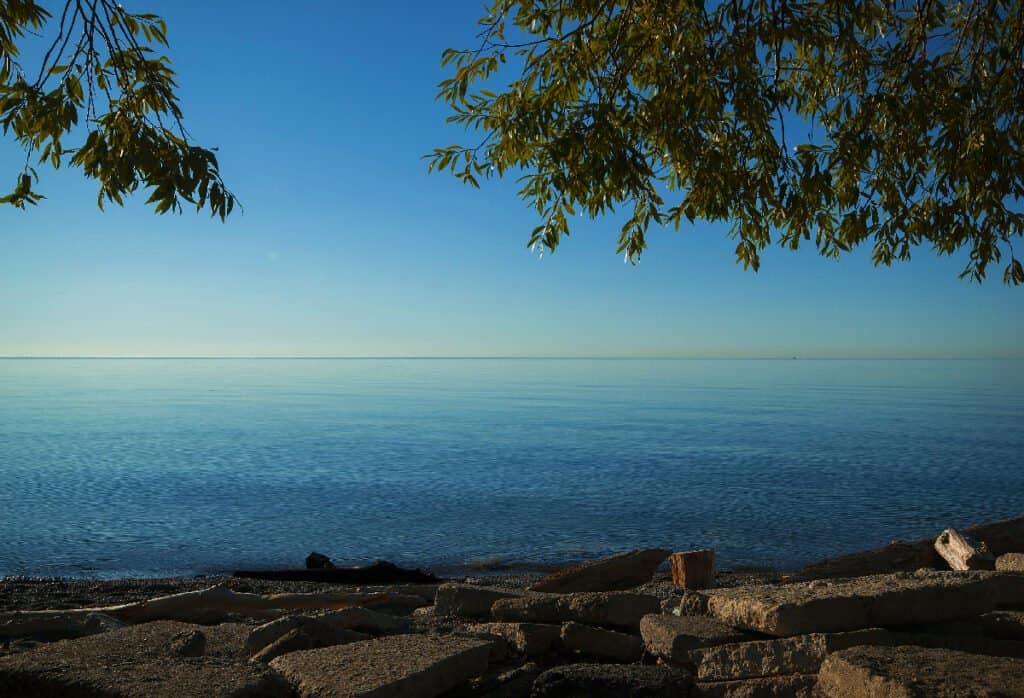
Lake Ontario is the smallest Great Lake
©Michael J. Eves/Shutterstock.com
Another Great Lake, Lake Ontario, measures a maximum depth of 802 feet or 244 meters, making it one of the continent’s deepest lakes. It holds 1,640 cubic kilometers of water with a surface area of 7,340 square miles or 18,960 square kilometers. Both the United States and Canada share the lake through Ontario and New York.
14. Okanagan Lake, Canada
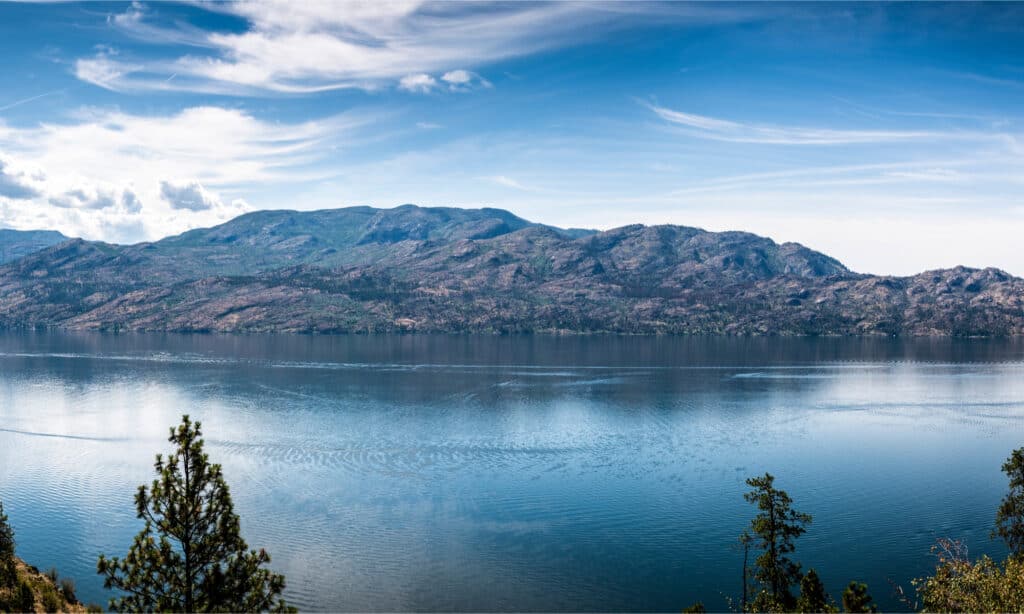
With a maximum depth of 232 meters, Okanagan Lake is the 14th deepest lake in North America.
©RLS Photo/Shutterstock.com
Another lake in British Columbia makes it to the list. Okanagan Lake has a maximum depth of 761 feet or 232 meters and is considered a fjord lake as it was carved through successive glaciations. The lake is also known for its Okanagan Valley, in which terraces are now used for agriculture like fruit cultivation.
15. Lake Athabasca, Canada
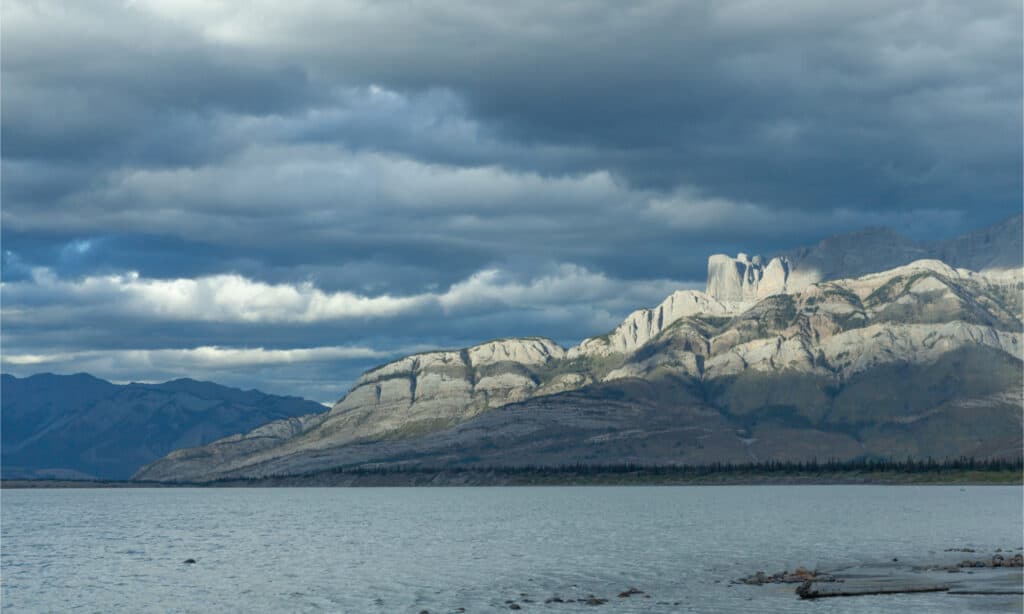
Lake Athabasca is famous for its economically significant commercial fishing.
©Vladislav Mavrin/Shutterstock.com
Lake Athabasca is a lake in Alberta, Canada, with a maximum depth of 407 feet or 124 meters. The lake is famous for its rich fishing opportunities and is economically significant for commercial fishing. Some fish found in the area include whitefish, lake trout, goldeye, walleye, yellow perch, and northern pike. The lake’s north shore was also a vital uranium and gold mining hub.
Summary Of The 15 Deepest Lakes In North America
| Rank | Lake | Depth | Location |
|---|---|---|---|
| 1 | Great Slave Lake | 2014 feet | Northwest Territories, Canada |
| 2 | Crater Lake | 1943 feet | Oregon, United States |
| 3 | Quesnel Lake | 1677 | British Columbia, Canada |
| 4 | Lake Tahoe | 1645 | California & Nevada, United States |
| 5 | Adams Lake | 1499 | British Columbia, Canada |
| 6 | Chelan Lake | 1486 | Washington, USA |
| 7 | Great Bear Lake | 1463 | Northwest Territories, Canada |
| 8 | Lake Superior | 1333 | Wisconsin & Michigan, United States & Ontario, Canada |
| 9 | Lake Pend Oreille | 1150 | Idaho, United States |
| 10 | Reindeer Lake | 720 | Manitoba & Saskatchewan, Canada |
| 11 | Iliamna Lake | 988 | Alaska, United States |
| 12 | Lake Michigan | 923 | Michigan, Illinois, Indiana, and Wisconsin, United States |
| 13 | Lake Ontario | 802 | New York, United States & Ontario, Canada |
| 14 | Okanagan Lake | 761 | British Columbia, Canada |
| 15 | Lake Athabasca | 407 feet | Alberta, Canada |
Other Deep Lakes Worth a Mention:
As with any list of the largest, deepest, hottest, coldest, or whatever, the data differs according to when and how the measurements were taken. For example, some researchers would list Lake Athabasca as #14 with a depth of just 243 feet and Okanagan Lake as #15 at 232 feet.
Other lists would have two lakes between Lake Tahoe and Lake Adams. They are:
Grand Lake, Newfoundland and Labrador, Canada – 984-1558 feet. This large lake is on the west interior of the Island of Newfoundland. Within the lake is Glover Island (18th largest in-lake island in the world). It is fed by two other lakes, Sandy and Birchy, and numerous small streams. This reservoir drains into Deer Lake via the Newfoundland Canal and then into the Humber River and Humber Arm, emptying into the Bay of Islands. It was built for the hydro-electric generating station at Deer Lake, which was constructed to provide electricity to the pulp and paper mill at Corner Brook.
Seton Lake, British Columbia, Canada – 348-1,509 feet. Located in the Squamish-Lillooet region and bordered on the northeast by Mission Ridge and on the southwest by the Cayoosh Range. The reservoir’s recreation area is part of the Bridge River hydroelectric complex and includes campgrounds, picnic areas, a range of activities.
The photo featured at the top of this post is © Sorayot Chinkanjanarot/Shutterstock.com
Thank you for reading! Have some feedback for us? Contact the AZ Animals editorial team.



